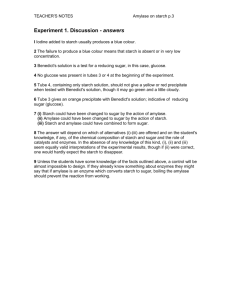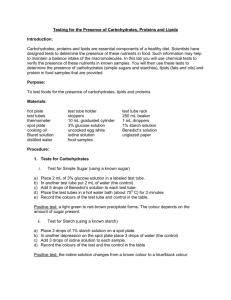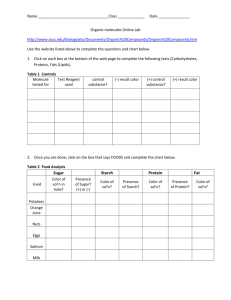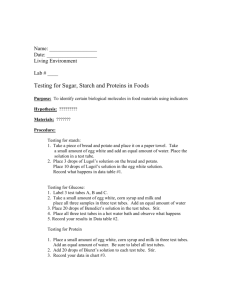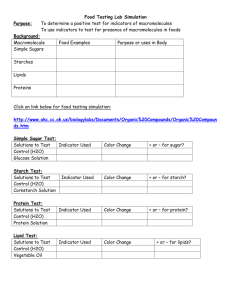Lab: Detecting Organic Compounds
advertisement
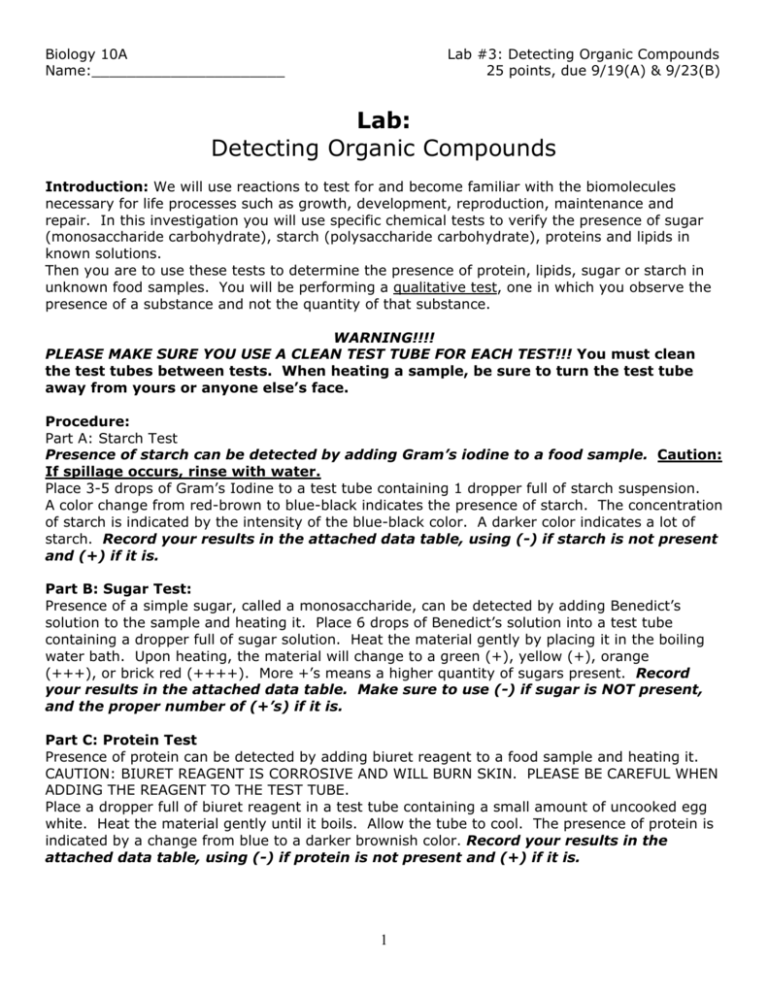
Biology 10A Name:______________________ Lab #3: Detecting Organic Compounds 25 points, due 9/19(A) & 9/23(B) Lab: Detecting Organic Compounds Introduction: We will use reactions to test for and become familiar with the biomolecules necessary for life processes such as growth, development, reproduction, maintenance and repair. In this investigation you will use specific chemical tests to verify the presence of sugar (monosaccharide carbohydrate), starch (polysaccharide carbohydrate), proteins and lipids in known solutions. Then you are to use these tests to determine the presence of protein, lipids, sugar or starch in unknown food samples. You will be performing a qualitative test, one in which you observe the presence of a substance and not the quantity of that substance. WARNING!!!! PLEASE MAKE SURE YOU USE A CLEAN TEST TUBE FOR EACH TEST!!! You must clean the test tubes between tests. When heating a sample, be sure to turn the test tube away from yours or anyone else’s face. Procedure: Part A: Starch Test Presence of starch can be detected by adding Gram’s iodine to a food sample. Caution: If spillage occurs, rinse with water. Place 3-5 drops of Gram’s Iodine to a test tube containing 1 dropper full of starch suspension. A color change from red-brown to blue-black indicates the presence of starch. The concentration of starch is indicated by the intensity of the blue-black color. A darker color indicates a lot of starch. Record your results in the attached data table, using (-) if starch is not present and (+) if it is. Part B: Sugar Test: Presence of a simple sugar, called a monosaccharide, can be detected by adding Benedict’s solution to the sample and heating it. Place 6 drops of Benedict’s solution into a test tube containing a dropper full of sugar solution. Heat the material gently by placing it in the boiling water bath. Upon heating, the material will change to a green (+), yellow (+), orange (+++), or brick red (++++). More +’s means a higher quantity of sugars present. Record your results in the attached data table. Make sure to use (-) if sugar is NOT present, and the proper number of (+’s) if it is. Part C: Protein Test Presence of protein can be detected by adding biuret reagent to a food sample and heating it. CAUTION: BIURET REAGENT IS CORROSIVE AND WILL BURN SKIN. PLEASE BE CAREFUL WHEN ADDING THE REAGENT TO THE TEST TUBE. Place a dropper full of biuret reagent in a test tube containing a small amount of uncooked egg white. Heat the material gently until it boils. Allow the tube to cool. The presence of protein is indicated by a change from blue to a darker brownish color. Record your results in the attached data table, using (-) if protein is not present and (+) if it is. 1 Biology 10A Name:______________________ Lab #3: Detecting Organic Compounds 25 points, due 9/19(A) & 9/23(B) Part D: Lipid Test (Brown Paper Bag Test) One way to test for the presence of fats is to rub the sample on brown paper. Place a small drop of cooking oil on a small piece of brown paper. Rub the oil over an area of approximately 5 cm, and allow it to sit for 15 minutes. A translucent spot on the paper indicates the presence of fat. Hold the paper towards a light to see the spot. Record your results in the attached data table, using (-) if fat is not present and (+) if it is. Part E: Testing Unknowns Begin by visually examining each of the 5 unknowns. Based on appearance, hypothesize as to which organic compound(s) you think each unknown will contain. You may choose more than one organic compound for any or all of the unknown food samples. Once your Hypothesis it complete, test each softened food sample for the presence of starch, sugar, lipid, and protein. Perform each of the tests learned in Parts A-D of this lab on EACH unknown sample. Some samples might contain more than one biomelecule, in which case they will show up positive for more than one test. - Blue (no sugar) + Green Sugar Test Results: ++ Yellow ++++ Brick Red (the most sugar) +++ Orange Starch, Fat and Protein Results: - Specific molecule absent + Specific molecule present Material Letter A B C D E Starch Hypothesis Sugar Protein Lipid Table 1: Hypothesis of organic compound content for each of the unknown food samples. 2 Biology 10A Name:______________________ Lab #3: Detecting Organic Compounds 25 points, due 9/19(A) & 9/23(B) Record all results in the following Data table: Organic Molecule Test Results Material to be tested Cooking Oil Starch Test Sugar Test Protein Test Fat Test Observations (color change, etc) Egg White Glucose Starch Solution A B C D E Table 1: Actual test results of organic compound content for each of the unknown food samples. Conclusion Questions: 1. Name any foods tested that have more than one compound present. 2. In the test for sugar, why do some tubes show a green color while others show a brick red? 3. What factors might have hindered the four different tests? How could these factors be corrected? 3 Biology 10A Name:______________________ Lab #3: Detecting Organic Compounds 25 points, due 9/19(A) & 9/23(B) 4. What is the difference between a qualitative and a quantitative experiment? 5. What is the purpose of testing standards first for this type of experiment? Significance Task: Design a way to express your data graphically. 4



